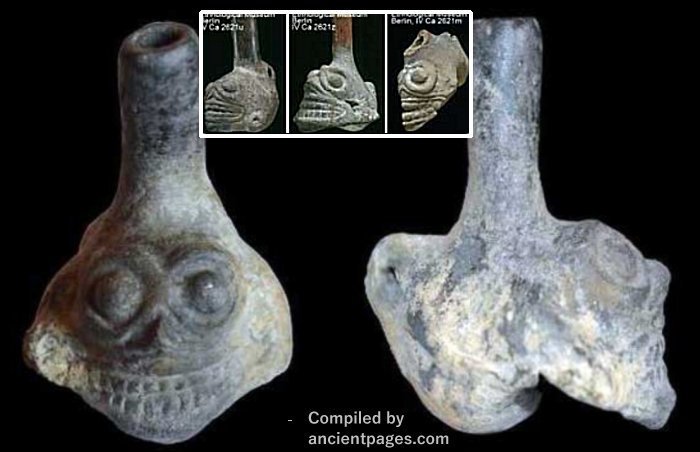Conny Waters – AncientPages.com – Ancient sound tools and musical instruments have been found worldwide. Since the Paleolithic era, humans crafted instruments to mimic environmental sounds and for aesthetic or symbolic purposes.
Aztec Death Whistle. Image credit: Jennysnest – CC BY-SA 4.0
These instruments often carry natural or mythological significance in their culture due to their sound quality and visual appearance,” write researchewrs in their paper.
A recent study illuminates the profound and chilling effects of the ancient Aztec skull-shaped “death whistles,” ancient instruments, known for their disturbing, scream-like sounds.
These clay whistles have been discovered in burial sites dating from c. 1250 to 1521 CE, and shed more light on their historical value and the cultural practices of the Aztec civilization. Researchers found that the primary goal of the creation of such terrifying instruments was to create psychological and neurological responses even in contemporary audiences.
Original exemplars and replicas of Aztec skull whistles. Credit: Communications Psychology (2024). DOI: 10.1038/s44271-024-00157-7
The study shows that the whistles’ eerie tones had psychoacoustic properties used in ancient rituals or warfare tactics in the Aztec society.
Additionally, a recent study shows that skull whistle sounds are predominantly perceived as aversive and scary and as having a hybrid natural-artificial origin. Skull whistle sounds attract mental attention by effectively mimicking other aversive and startling sounds produced by nature and technology.
Archaeologists have found many enigmatic small, clay whistles, formed into the shape of a skull, emit a high-pitched, piercing sound that eerily mimics a human scream. This haunting auditory experience is produced by the intricate collision of airstreams within the confines of the instrument’s design.
Additionally, researchers say that the whistles may have had dual functions within Aztec society.
They were perfect as tools for psychological warfare, designed to instill fear and panic among enemies on the battlefield with their unsettling noise.
Secondly, they are believed to have held significant roles in ceremonial rites associated with death and sacrifice, potentially used to accompany rituals honoring deities or as symbolic representations of the transition from life to death in Aztec cosmology.
Skull whistle sounds attract mental attention by effectively mimicking other aversive and startling sounds produced by nature and technology.
According to researchers, to date, only theoretical frameworks exist regarding the visual, acoustic, and contextual iconography of skull whistles.
It seems to be a complex symbolism rooted in the cultural and mythological codex of the Aztecs. The visual iconography resembling a skull may depict Mictlantecuhtli, the Aztec Lord of the Underworld, potentially linking these artifacts to Aztec sacrificial practices.
The auditory iconography suggests a possible connection with Ehecatl, the Aztec God of Wind, who ventured into the underworld to retrieve bones from previous world ages for human creation—a notion we refer to as the “deity symbolism hypothesis.”
In terms of discovery context and location—often ritual burial sites involving human sacrifices—the skull whistles might possess ritualistic and ceremonial significance related to mythological journeys into Mictlan, the Aztec underworld following sacrificial death. Notably, Mictlan’s fifth level is characterized by lethal winds that are sharp and piercing in nature; this aligns with its potential sound iconography—a concept we term as “ritual symbolism hypothesis.”
Furthermore, this is relevant considering the rich tradition within Aztec culture for sound imitation through instruments designed to replicate environmental sounds (such as wind or rain), animal calls (like bird calls or snake hisses), or human sounds (such as screams), many of which were employed in ritual contexts.
Paper – Frühholz, S., Rodriguez, P., Bonard, M. et al. (2024). Psychoacoustic and Archeoacoustic nature of ancient Aztec skull whistles. Commun Psychol 2, 108. doi:10.1038/s44271-024-00157-7
Written by Conny Waters – AncientPages.com Staff Writer







